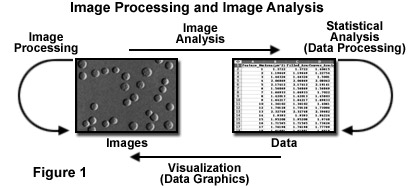Overview of Image Processing and Analysis

Why do this? There are several reasons; a few are: to assist the human viewer in observing or communicating information in images; to minimize human bias based on wish or expectation; to introduce rigor into the process of obtaining quantitative information as a substitute for anecdote; and not least, to make us better and more aware viewers of images. Unassisted human vision is rarely a reliable scientific tool. Henry David Thoreau said “The question is not what you look at, but what you see.”
The procedures in the following sections are generally applied in the order shown, as appropriate to a given image and final purpose (i.e., skip those steps that are not required in a particular application, but work from the top down). The general sequence of operations is:
- Correct or mitigate image imperfections and defects.
- Enhance important details by suppressing other information.
- Create a binary representation of the structures of interest.
- Perform measurements on features and/or overall structure.
Of course, original images should be archived and all processing and measurement steps documented.
Contributing Authors
John C. Russ - Materials Science and Engineering Dept., North Carolina State University, Raleigh, North Carolina, 27695.
Matthew Parry-Hill and Michael W. Davidson - National High Magnetic Field Laboratory, 1800 East Paul Dirac Dr., The Florida State University, Tallahassee, Florida, 32310.
BACK TO INTRODUCTION TO DIGITAL IMAGE PROCESSING AND ANALYSIS
BACK TO MICROSCOPY PRIMER HOME
